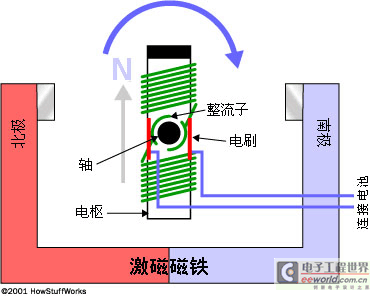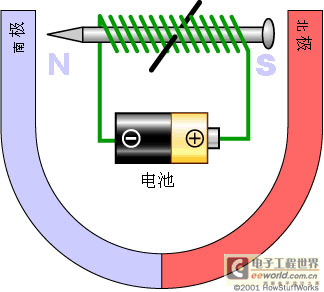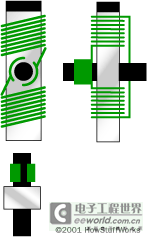How Electric Motors Work
1. Introduction 2. Internal structure of the motor 3. Toy motor 4. Other parts of the motor 5. Electromagnet and motor 6. Armature, commutator and brushes 7. Motor assembly 8. Applications of motorsintroduction
Electric motors are everywhere! Almost all the mechanical movement you see around the house is produced by an AC (alternating current) or DC (direct current) motor.

|
By understanding how electric motors work, we can learn a lot about magnets, electromagnets, and electricity in general. This article will explain what makes electric motors keep turning.
Internal structure of the motor
Let's first look at the general plan of a simple bipolar DC motor. The simple motor consists of six parts, as shown in the figure below:
- Armature or rotor
- Commutator
- Brush
- axis
- Field Magnet
- Some type of DC power supply

Components of an electric motor |
The way electric motors work is all about magnets and magnetism: they use magnets to create motion. If you've ever played with magnets, you know that all magnets have this basic law: like poles repel each other, and unlike poles attract each other. So if you have two magnets, each with a "north" and a "south" on each end, the north pole of one magnet will attract the south pole of the other magnet. Conversely, the north pole of one magnet will repel the north pole of the other magnet (and vice versa). Inside an electric motor, these forces of attraction and repulsion create the rotational motion.
In the picture above, you can see that there are two magnets in the motor: the armature (or rotor), which is an electromagnet, and the field magnet, which is a permanent magnet (the field magnet can also act as an electromagnet, but in most small motors, people don't use it as an electromagnet to save power).
Toy Motors
The motor disassembled here is a simple electric motor commonly found in toys:

|
You can see that this is a small motor, about the size of a dime. From the outside, you can see the steel structure that makes up the body of the motor, a shaft, a nylon end cap, and two battery leads. If you connect the motor's battery leads to the flashlight's batteries, the shaft will turn. If you reverse the leads, the shaft will turn in the opposite direction. Here are two more views of the same motor. (Note the two slots on the side of the steel shell in the second view; you'll see what they are for later)

|

|
The nylon end cap is held in place by two springs that make up the steel housing. If you push the springs back, you can release the end cap and remove it. On the inside of the end cap you can see the motor's brushes. These brushes transfer power from the battery to the commutator as the motor spins:

|

|
Other parts of the motor
The shaft holds the armature and commutator. In this case, the armature is a set of electromagnets. The armature in this motor is a set of thin metal sheets stacked together with thin copper wire wound around each of the three poles. Each end of each wire (one wire per pole) is soldered to a terminal, and each of the three terminals is connected to one of the plates of the commutator. The following figure provides a convenient way to see the armature, terminals, and commutator:

|

|
The final component of any DC motor is the field magnet. The field magnet in this motor consists of the housing itself and two arc-shaped permanent magnets:

|

|
One end of each magnet fits into a slot cut into the housing, and the other end is clamped onto the other two ends of the two magnets by a retaining clip.
Electromagnets and motors
To understand how electric motors work, it is key to understand how electromagnets work. (See How Electromagnets Work for complete details.)
Electromagnets are the basis of electric motors. Imagine this scenario and you'll understand how the inner workings of an electric motor work. Let's say you make a simple electromagnet by wrapping 100 turns of wire around a nail and then connecting the nail to a battery. When the battery is connected, the nail becomes a magnet with a north and south pole.
Now take this nail electromagnet, stick a shaft through the middle of it, and suspend it in the center of the horseshoe magnet, as shown below. If you connect a battery to the electromagnet so that the north pole of the nail is oriented as shown, the basic laws of magnetism will tell you what will happen: the north pole of the electromagnet will repel the north pole of the horseshoe magnet and be attracted to the south pole of the horseshoe magnet. The south pole of the electromagnet will repel in a similar manner. The nail will move half a revolution and then stop in the position shown.

The electromagnet in a horseshoe magnet |
You can see that this half-turn of motion is simply the result of the magnets naturally attracting and repelling each other. The key to building an electric motor is to go one step further and flip the electromagnet's magnetic field at the exact moment the half-turn is completed. This flip allows the electromagnet to complete another half-turn. Changing the direction of the flow of electrons in a wire (turning a battery around can accomplish this) flips the magnetic field. If you can flip the electromagnet's magnetic field at the exact right time to complete each half-turn, the motor will spin freely.
Armature, commutator and brushes

Armature |
The armature has a shaft to which the commutator is attached. In the image to the right, you can see the same armature in three different views: front, side, and back. The back view does not include the windings to show the commutator more clearly. You can see that the commutator is nothing more than a pair of plates attached to the shaft. These plates are connected to the two terminals of the electromagnet coil.

Brushes and commutators |
The diagram to the right shows how the commutator and brushes work as a unit to keep the current flowing to the electromagnet and to flip the direction of the electron flow at the appropriate time. The contacts of the commutator are connected to the shaft of the electromagnet, allowing the shaft to rotate with the magnet. The brushes are just two pieces of springy metal or carbon that are in contact with the commutator.
Motor assembly
Put all these parts together and you have a complete electric motor:

Armature |
The armature windings have been omitted from this diagram so that you can more easily see the operation of the commutator. The key thing to observe is that when the armature moves laterally, the poles of the electromagnet flip. Because of this flip, the north pole of the electromagnet is always above the shaft, thereby repelling the north pole of the field magnet and attracting the south pole of the field magnet.
If you ever have the opportunity to disassemble a small electric motor, you will find that it contains the same parts described above: two small permanent magnets, a commutator, two brushes, and an electromagnet (made by winding wire around a piece of metal). However, the rotor almost always has three poles, not the two shown in this article. Using three poles in an electric motor provides two advantages:
-
Makes the motor more dynamic. In a two-pole motor, if the electromagnet is at the equilibrium point, that is, completely horizontal between the poles of the field magnet when the motor is started, you can imagine that the armature will "stuck" in this position. This will never happen in a three-pole motor.
- In a two-pole motor, every time the commutator reaches the point where it flips the magnetic field, it short-circuits the battery (connecting the positive and negative terminals directly together) for a moment. This short-circuit wastes energy and discharges the battery unnecessarily. A three-pole motor solves this problem as well.
Depending on the size of the motor and its specific purpose, you can use any number of poles.
Application of electric motors
Look around your house and you'll notice electric motors everywhere. Here's a fun survey you can try: Walk around the house and count all the electric motors you find. Starting in the kitchen, electric motors are used in the following places:
- Fans above stoves and in microwaves
- Drain under sink
- Blender
- Can opener
- A refrigerator - in fact, it has two or three motors: one for the compressor, one for the fan inside the refrigerator, and one for the ice maker
- mixer
- Tape player in answering machine
- Even the clock on your oven may have used an electric motor.
Electric motors are used in the following locations in the utility room:
- washing machine
- Dryer
- Electric screwdriver
- Vacuum cleaners and micro vacuum cleaners
- Electric saw
- Electric drill
- Furnace Blowers
Electric motors can even be found in bathrooms:
- fan
- Electric toothbrush
- Hair dryer
- Electric shaver
There are also some electric motors in cars:
- Automatic opening and closing windows (each window is equipped with an electric motor)
- Automatically adjustable seats (up to seven electric motors per seat)
- Heater and radiator fans
- Windshield wipers
- Starter Motor
- Wireless device electric antenna
In addition, there are various other places where electric motors exist:
- There are several motors in a VCR.
- There are several electric motors in a CD player or a large tape recorder.
- There are many motors in a computer (two or three for the disk drives, plus one or two for the fans)
- Most motion toys contain at least one motor (like the one Tickle-me-Elmo uses when it vibrates)
- Electronic clock
- Garage door opener
- Fish tank pump
After walking around the room, I counted more than 50 motors hidden in various devices. Each moving device uses an electric motor to achieve its movement.
Previous article:Working principle of electronic door
Next article:What is a cellular network
- Popular Resources
- Popular amplifiers
- High signal-to-noise ratio MEMS microphone drives artificial intelligence interaction
- Advantages of using a differential-to-single-ended RF amplifier in a transmit signal chain design
- ON Semiconductor CEO Appears at Munich Electronica Show and Launches Treo Platform
- ON Semiconductor Launches Industry-Leading Analog and Mixed-Signal Platform
- Analog Devices ADAQ7767-1 μModule DAQ Solution for Rapid Development of Precision Data Acquisition Systems Now Available at Mouser
- Domestic high-precision, high-speed ADC chips are on the rise
- Microcontrollers that combine Hi-Fi, intelligence and USB multi-channel features – ushering in a new era of digital audio
- Using capacitive PGA, Naxin Micro launches high-precision multi-channel 24/16-bit Δ-Σ ADC
- Fully Differential Amplifier Provides High Voltage, Low Noise Signals for Precision Data Acquisition Signal Chain
- Innolux's intelligent steer-by-wire solution makes cars smarter and safer
- 8051 MCU - Parity Check
- How to efficiently balance the sensitivity of tactile sensing interfaces
- What should I do if the servo motor shakes? What causes the servo motor to shake quickly?
- 【Brushless Motor】Analysis of three-phase BLDC motor and sharing of two popular development boards
- Midea Industrial Technology's subsidiaries Clou Electronics and Hekang New Energy jointly appeared at the Munich Battery Energy Storage Exhibition and Solar Energy Exhibition
- Guoxin Sichen | Application of ferroelectric memory PB85RS2MC in power battery management, with a capacity of 2M
- Analysis of common faults of frequency converter
- In a head-on competition with Qualcomm, what kind of cockpit products has Intel come up with?
- Dalian Rongke's all-vanadium liquid flow battery energy storage equipment industrialization project has entered the sprint stage before production
- Allegro MicroSystems Introduces Advanced Magnetic and Inductive Position Sensing Solutions at Electronica 2024
- Car key in the left hand, liveness detection radar in the right hand, UWB is imperative for cars!
- After a decade of rapid development, domestic CIS has entered the market
- Aegis Dagger Battery + Thor EM-i Super Hybrid, Geely New Energy has thrown out two "king bombs"
- A brief discussion on functional safety - fault, error, and failure
- In the smart car 2.0 cycle, these core industry chains are facing major opportunities!
- The United States and Japan are developing new batteries. CATL faces challenges? How should China's new energy battery industry respond?
- Murata launches high-precision 6-axis inertial sensor for automobiles
- Ford patents pre-charge alarm to help save costs and respond to emergencies
- New real-time microcontroller system from Texas Instruments enables smarter processing in automotive and industrial applications
- [Synopsys IP Resources] Enabling Low-Power Machine Learning for Smart IoT Applications
- Relationship between PWM frequency and duty cycle
- Prize live broadcast: C-V2X (Internet of Vehicles) test challenges and solutions, make an appointment to win Keysight gifts
- Is there anything wrong with this STC procedure?
- Testing of heating power of NOx sensor
- IoT access terminal
- How to Measure Cable Impedance and Loss Using a Vector Network Analyzer
- Make Magazine: Getting started with Python on hardware
- Does the LCD module need to be grounded when used?
- 【BLE 5.3 wireless MCU CH582】11. Mobile app controls the LED on and off

 EL5111AIYEZ-T13
EL5111AIYEZ-T13











 京公网安备 11010802033920号
京公网安备 11010802033920号